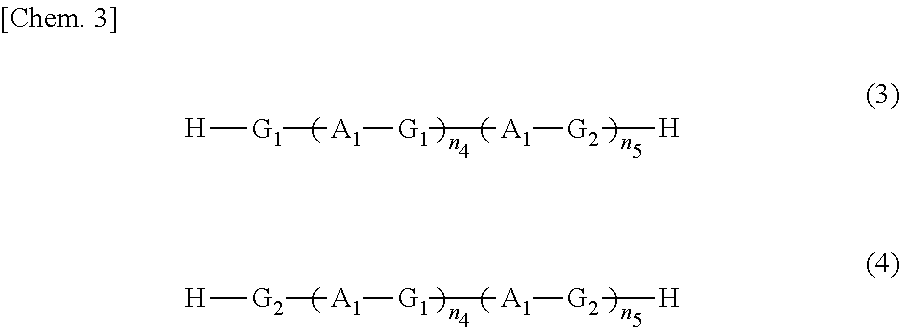Cellulos ester resin modifier, cellulos ester resin composition, optical film, method for producing polarizing-plate protective film, and liquid crystal display device
a technology of cellulos ester and cellulos ester, which is applied in the direction of instruments, polarising elements, optical elements, etc., can solve the problems of insufficient compatibility with cellulos ester resin and film becomes opaque, and achieves excellent water vapor permeability resistance and dimensional stability against heat, and low contamination of the film production line. , the effect of high volatilization resistan
- Summary
- Abstract
- Description
- Claims
- Application Information
AI Technical Summary
Benefits of technology
Problems solved by technology
Method used
Image
Examples
synthesis example 1
[Synthesis of Polyester Polyol (A)]
[0125]310 g of adipic acid (hereinafter abbreviated as “AA”), 944 g of phthalic anhydride (hereinafter abbreviated as “PA”), 922 g of propylene glycol (hereinafter abbreviated as “PG”), and 0.131 g of tetraisopropoxytitanium (hereinafter abbreviated as “TiPT”) were put into a 3 L four-necked flask equipped with a thermometer, a stirrer, a nitrogen introducing tube, and a rectification column, and then the temperature was raised to 220° C. and a dehydration esterification reaction was carried out while removing generated water. When the acid value of the reaction product reached 1 or less, the reaction product was filtered and taken out to obtain a transparent yellow liquid polyester polyol (A1). The number average molecular weight (Mn) of the polyester polyol (A1) was 790, the weight average molecular weight (Mw) was 1,300, the (Mw) / (Mn) was 1.6, the acid value was 0.5, and the hydroxyl value was 163. Here, the acid value was measured according to ...
synthesis example 2 (
Same as Above)
[0126]1,111 g of PA, 365 g of AA, 987 g of PG, and 0.148 g of TiPT were put into a 3 L four-necked flask equipped with a thermometer, a stirrer, a nitrogen introducing tube, and a rectification column, and then the temperature was raised to 220° C. and a dehydration esterification reaction was carried out while removing generated water. When the acid value of the reaction product reached 1 or less, the reaction product was filtered and taken out to obtain a transparent yellow liquid polyester polyol (A2). The number average molecular weight (Mn) of the polyester polyol (A2) was 920, the weight average molecular weight (Mw) was 1,770, the (Mw) / (Mn) was 1.9, the acid value was 0.6, and the hydroxyl value was 119.
synthesis example 3 (
Same as Above)
[0127]365 g of AA, 1,111 g of PA, 943 g of PG, and 0.145 g of TiPT were put into a 3 L four-necked flask equipped with a thermometer, a stirrer, a nitrogen introducing tube, and a rectification column, and then the temperature was raised to 220° C. and a dehydration esterification reaction was carried out while removing generated water. When the acid value of the reaction product reached 1 or less, the reaction product was filtered and taken out to obtain a transparent yellow liquid polyester polyol (A3). The number average molecular weight (Mn) of the polyester polyol (A3) was 1130, the weight average molecular weight (Mw) was 2,270, the (Mw) / (Mn) was 2.0, the acid value was 0.7, and the hydroxyl value was 82.
PUM
| Property | Measurement | Unit |
|---|---|---|
| mass ratio | aaaaa | aaaaa |
| temperature | aaaaa | aaaaa |
| thickness | aaaaa | aaaaa |
Abstract
Description
Claims
Application Information
 Login to View More
Login to View More - R&D
- Intellectual Property
- Life Sciences
- Materials
- Tech Scout
- Unparalleled Data Quality
- Higher Quality Content
- 60% Fewer Hallucinations
Browse by: Latest US Patents, China's latest patents, Technical Efficacy Thesaurus, Application Domain, Technology Topic, Popular Technical Reports.
© 2025 PatSnap. All rights reserved.Legal|Privacy policy|Modern Slavery Act Transparency Statement|Sitemap|About US| Contact US: help@patsnap.com



